Organisation of the fire test protocol in Railway according to EN 45545-2
Recognized by CERTIFER (SNCF/RATP) and accredited by the COFRAC, CREPIM edits test report in accordance with the NF F 16-101, NF F 16-102 and EN 45545-2 standards and give you a direct access to the French and European railway market.
The EN 45545-2 deployment
June 2013 :
- The EN version of the standard is planned to appear at AFNOR
- The interoperability technical specification (ITS) is also planned
From june 2013 to 2016 :
- As soon as the EN version was published, it entered in revision for a maximal period of three years. Ditto for the ITS
- Until here, each member state and each originator could explain what is wanted: to meet the EN 45545-2 requirements or to meet the national standard requirement (NF, DIN, BS, UNI, Spain, the other countries will follow...)
- How it should happen:
- For France: The EN 45545-2 will be asked first and if the material doesn’t meet the requirement, it would be possible to use a national standard.
- For Spain, Italy and probably Poland, the system should be the same.
- For England: the BS standard will be always required.
- For Germany: the deployment is still uncertain because each federation will keep the right to apply its own rules.
- In 3 years, which means in 2016, the EN 45545 will be unequivocally compulsory.
Presentation of the fire test according to EN 45545-2
1. ISO 5658-2, Lateral Flame Spread measurment – Propagation fire test
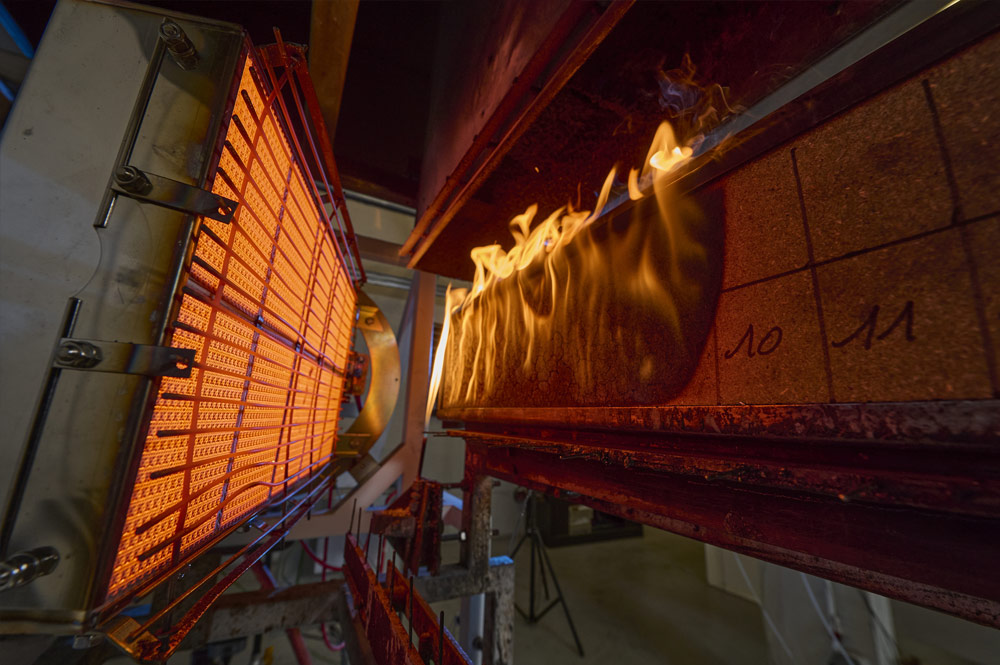
Principle : Specimens are held in a vertical orientation and exposed to a gas fired radiant panel and a non-impinging pilot flame. The hot end of the specimen receives a radiant heat flux of 50,5kW/m² and this gradually decreases to a level of 1.2 kW/m² at the cool end.
Although the pilot flame does not impinge on the surface of the specimen it will act as an ignition source for any volatile gases produced by the product. During the course of the test the maximum flame travel along the specimen is recorded. The following parameter is then determined: Critical Heat Flux at Extinguishment (C.H.F) - a measure of how far the flames have travelled across the surface of the specimen.
2. ISO 5660-1, Cone calorimeter test related to the measurment of the Rate of Heat Release
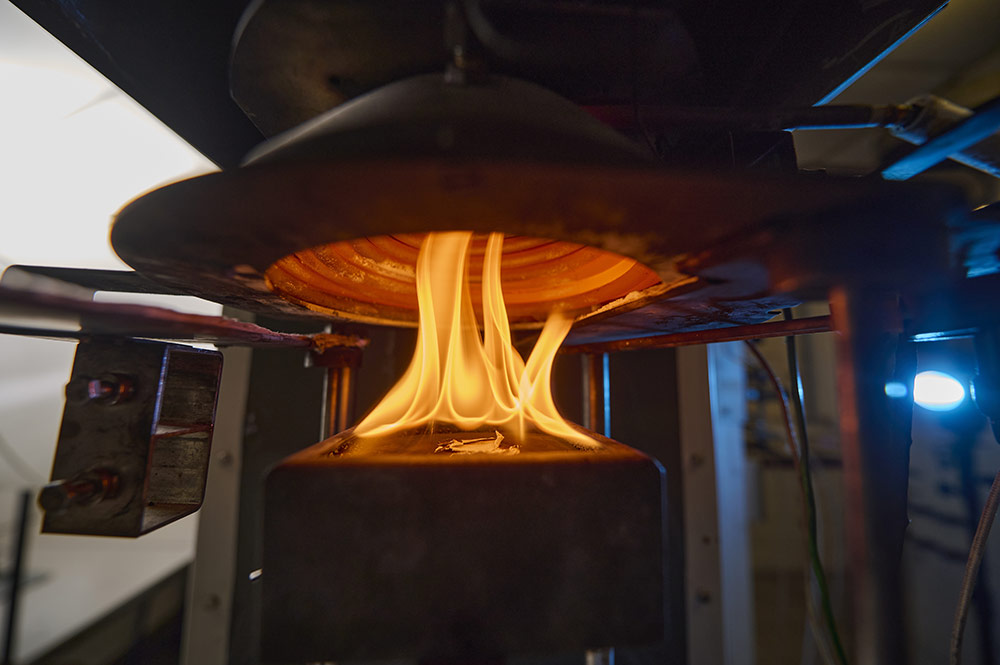
General : The Cone Calorimeter was developed in the USA by NIST and is used to determine the rate of heat release. The apparatus uses the principle of oxygen consumption calorimetry to determine the rate of heat release, maximum heat release and the total heat release.
Principle : The apparatus is designed to measure the response in either a vertical or horizontal position and is based on the premise that for a range of materials, the net heat of combustion is proportional to the amount of oxygen required for combustion. A small sample of material is exposed to the irradiance generated by a truncated cone heater. Decomposition gases generated by the heater are ignited by a spark and the resultant combustion gases are drawn through an exhaust system containing various instrumentation.

Continuous measurement of oxygen, carbon monoxide and carbon dioxide together with the exhaust flow rate allow the determination of heat release with time. A range of exposure conditions is used, from 10 kW/m² to 100 kW/m². In both orientations, the specimen is mounted on a load cell to measure mass loss which can itself be used to determine heat release rate. Smoke development and temperatures can also be monitored in the exhaust duct. The value which is required in the European standard is the MARHE which is directly linked to the heat rate release.
3. ISO 5659-2 fire test, Determination of Smoke Opacity
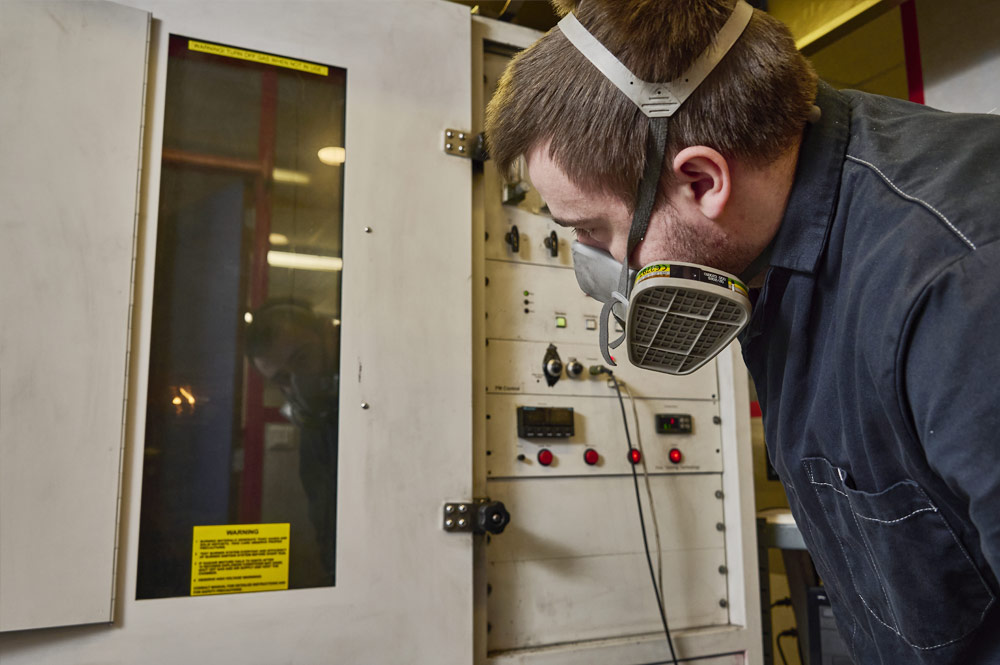
Principle : The aim of this test method of ISO 5659-2 ("Determination of Optical Density by a Single Chamber Test") is to expose a material to specified thermal conditions of pyrolysis and combustion in a continuous procedure. The change in optical density of the smoke produced when dispersed within a fixed volume of air is recorded throughout the period of test.
The resulting smoke density / time curve is used to calculate the specific optical density figures, which can be used to determine VOF4, Ds4min or Dsmax as required for the specific product function. The test is carried out in a chamber of 0.5m3 in volume. The specimen sits inside a small metal holder with one face left exposed (this ensures that it is a surface test only). The container is then placed inside the chamber below a cone heater in a horizontal position. The irradiance level of the cone heater is set to one of the following levels, depending on the specific product function:
- 25kW/m2 in the absence of a pilot flame
- 25kW/m2 in the presence of a pilot flame
- 50kW/m2 in the absence of a pilot flame
For smoke density measurment, VOF4 is calculated as follows :
VOF4 = Ds1min + Ds2min + Ds3min + (Ds4min/2)
Where Ds1min, Ds2min, Ds3min and Ds4min are the values of the specific optical density recorded at the 1st, 2nd, 3rd and 4th minutes respectively. Dsmax is the maximum specific optical density obtained within the 20 minutes test period.
4. EN 4554562 Annex C or EN 17084 : Determinaton of the smoke toxicity of the Gas in the ISO 5659-2 Smoke Chamber, connrected to FTIR analysis Technique

Principle for smoke and toxicity measurment : This particular test requirement can be conducted in conjunction with the smoke density analysis as described above. The sampling of fumes is made during the testing of each of the three specimens tested above, at 4 and 8 minutes test duration. The analysis of each relevant gas is made by an IRTF apparatus.
The concentration of each of the following toxic gases is recorded and compared to relevant reference values in order to determine the CIT value (the magnitude of the reference values is based on the danger posed from the gas in question):
- Carbon monoxide (CO)
- Carbon Dioxide (CO2)
-Hydrogen Bromide (HBr)
- Hydrogen Chloride (HCl)
- Hydrogen Cyanide (HCN)
- Hydrogen Fluoride (HF)
- Sulphur Dioxide (SO2)
- Nitrous Oxyde (NOx)
5. Other fire tests concerned by the EN 45545-2 and dedicated to the measurment of the spread of flame
- NF EN ISO 11925-2, Small flame test
- NF EN ISO 9239-1, Radiant Panel Floor – Flame propagation measurment
- ISO 4589-2, Determination of the Limit Oxygen Index - reaction to fire test
- NFX 70-100, Toxic gas emission
F CLASSIFICATION ACCORDING TO NF F 16-101/NF F 16-102 - FIRE TEST FOR DETERMINATION OF THE TOXICITY OF GAS
The F classification gives a smoke and toxic gas emission risk analysis when the material is burned. Two tests have to be led to obtain the F classification: the NF X70-100 and the NF X 10-702.
1. NFX 70-100, assessment of the smoke & gas toxicity
General: NF X 70-100 is a mass based toxic gas analysis test method. The test standard allows the measurement of many different toxic gases. For the purpose of F rating classification in accordance with NF F 16-101, the gases which are analyzed are as follows:
- Carbon monoxide (CO)
- Carbon Dioxide (CO2)
- Hydrogen Bromide (HBr)
- Hydrogen Chloride (HCl)
- Hydrogen Cyanide (HCN)
- Hydrogen Fluoride (HF)
- Sulphur Dioxide (SO2)
- Nitrous Oxyde (NOx)
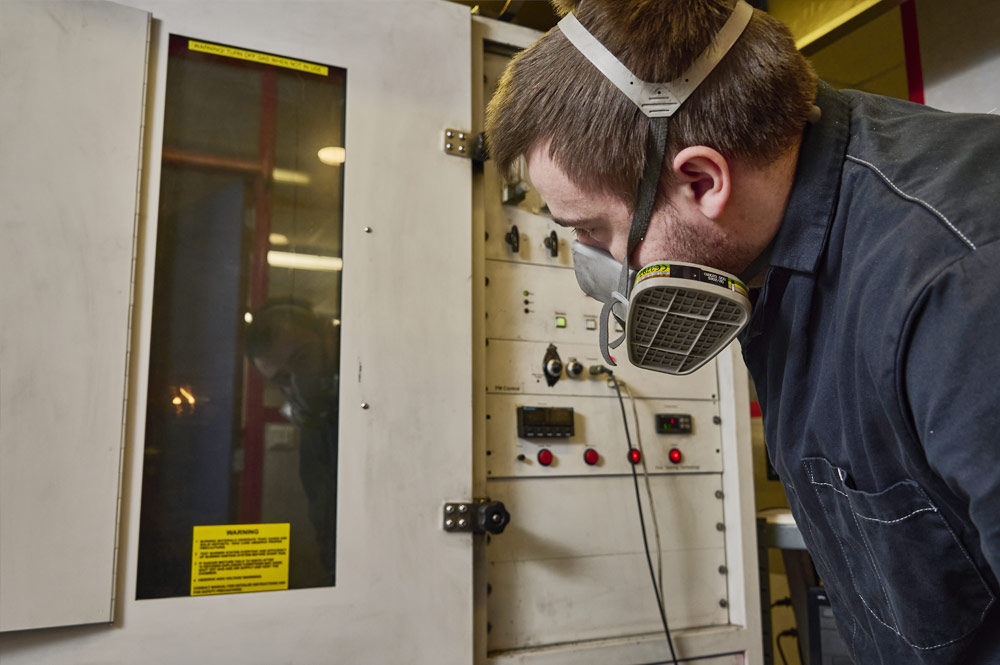
Principe of smoke toxicity determination : The fire test is conducted within a tube furnace where the temperature is generally 600°C (in some instances this can be 400°C or 800°C). Toxic fume emission testing is then carried out in triplicate and the average of these results is used to calculate the “CIT” Value. The collection / measurement of toxic fumes takes place throughout the 20 minutes test duration. The toxic fume emission is expressed in milligrams per gram of material, on the assumption that the mass of the test piece is 1g.
2. NF X 10-702, Determination of the opacity of smoke
General : The NF X 10-702 standard is a fire test method for the evaluation of smoke opacity. This standard can be used whenever a smoke opacity measurement is required on any type of material with respect to the requirements given in other reference documents. The NFX 10-702 fire test is mainly used within the frame of the F classification which is described in the NF F 16-101/102 standards.

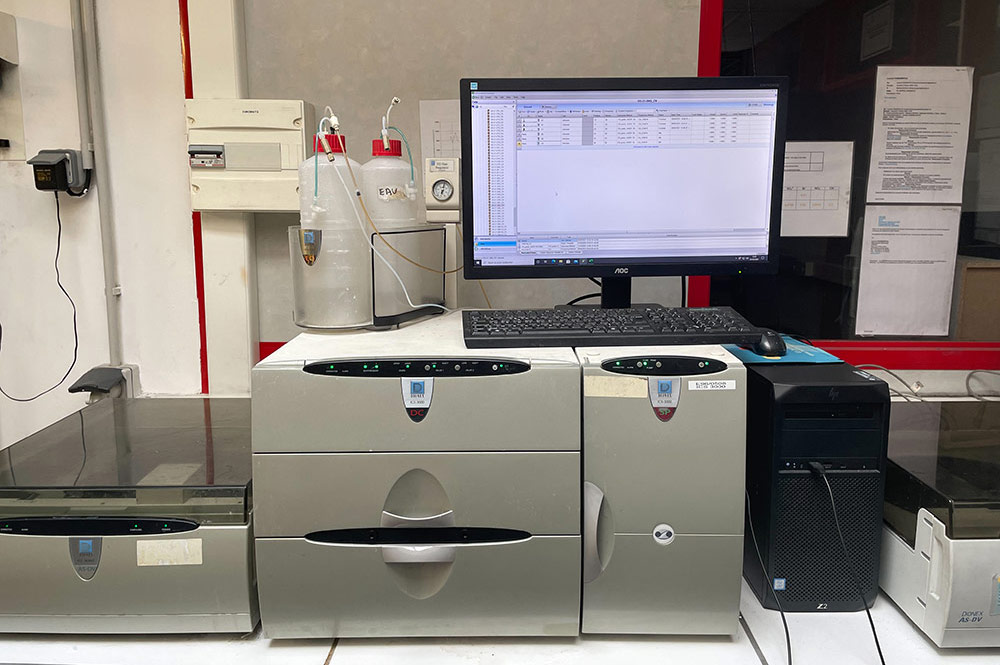
Principle : The aim of this test method – NF X 10-702 – ("Fire Test for measuring the specific optical density of smoke emitted by the combustion or pyrolysis of solid materials") is to expose a material to specified thermal conditions of pyrolysis and combustion in a continuous procedure. The change in optical density of the smoke produced when dispersed within a fixed volume of air is recorded throughout the period of test. The smoke density is measured using a white light beam which runs from the base of the chamber to a detector in the roof of the chamber, as smoke is produced less of the light reaches the detector. The resulting smoke density / time curve is used to calculate the smoke index. The actual values we record are: VOF4 value = a measurement of the rate of smoke production during the first four minutes of the fire test.
VOF4 is calculated as follows:
VOF4 = Ds1min + Ds2min + Ds3min + (Ds4min/2)
Where Ds1min, Ds2min, Ds3min and Ds4min are the values of the specific optical density recorded at the 1st, 2nd, 3rd and 4th minutes respectively. Dsmax is the maximum specific optical density obtained within the 20 minutes test period.
Calculation of F rating:
The CIT, VOF4 and Dsmax values are combined in a weighted calculation in order to determine a ‘Smoke Index’ S.I.. It is this value that is used to provide an F rating.
Smoke Index (S.I.) = Dsmax/100 + VOF4/30 + CIT/2
I CLASSIFICATION ACCORDING TO THE NF F 16-101 / NF F 16-102 : FLAMMABILITY TEST
1. ISO 4589-2, Limit of Oxygen Index determination, reaction to fire test
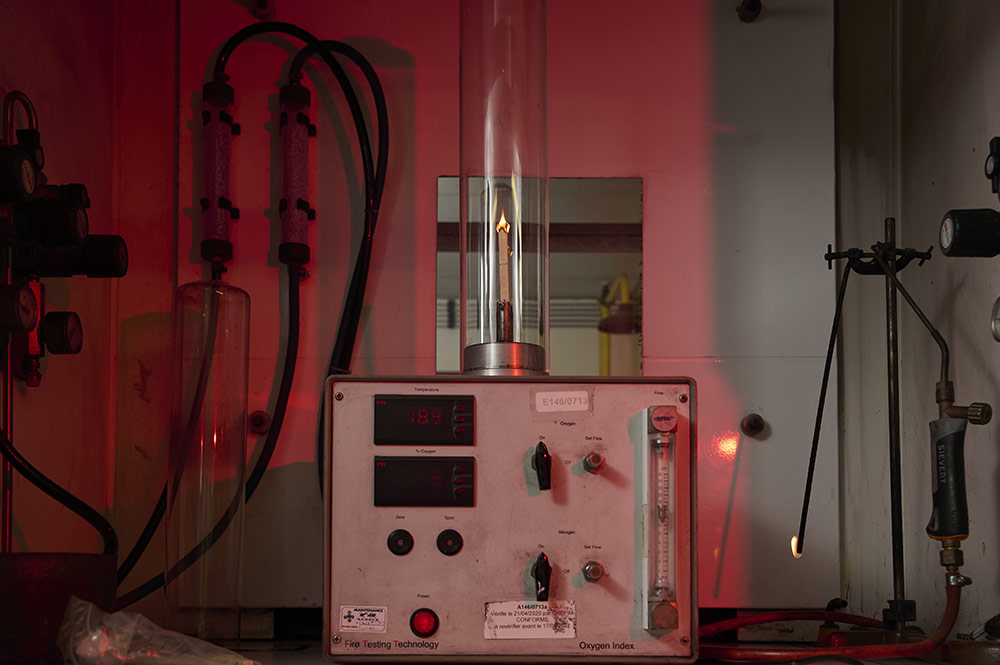
General : Fire Test Methods are provided for testing materials that are self-supporting in the form of vertical bars or sheet up to 10.5mm thick. A method is provided for testing flexible sheet of film materials while supported vertically. The results obtained are dependent upon the shape, orientation and isolation of the test specimen and the conditions of ignition.
ISO 4589 - Part 2 - Oxygen Index – Ambient Temperature Test
This Part of ISO 4589 specifies fire test methods for determining the minimum concentration of oxygen, in admixture with nitrogen that will support combustion of small vertical test specimens under specified test conditions. The test is performed at an ambient temperature of 23°C ± 2°C. The results are defined as oxygen index values define as LOI.
Principle : A small test specimen is supported vertically in a mixture of oxygen and nitrogen flowing upwards through a transparent chimney. The upper end of the specimen is ignited and the subsequent burning behavior of the specimen is observed to compare the period for which the burning continues, or the length of the specimen burnt, with specified limits for such burning. By testing a series of specimens in different oxygen concentrations, the minimum oxygen concentration is determined.
2. NF EN 60695-2-10/11/12, Glow Wire, IGNITION TEST related to E&E equipment
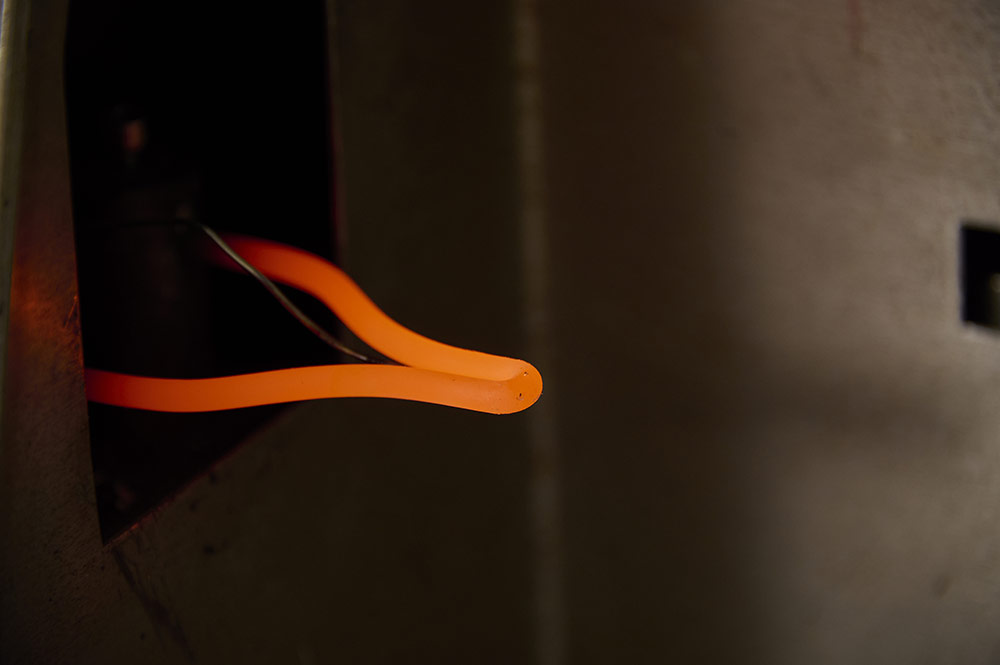
General : The glow wire is principally used for electro-technical material. It simulates the effect of a thermal stress on a point which can be produced by sources of heat such as the incandescent elements or by an overloaded of a resistance, over short periods, in order to evaluate in a simulated way the fire risks.
Principle : During a 30 seconds application of the glow wire on the material, following information are recorded : time of ignition, persistence of the ignition when the material is carried in contact with finger heating with 960 °C maximum (temperature of test determined according to the severity of use final of the apparatus) or after glowing.
M CLASSIFICATION ACCORDING TO NF F 16-101 - SPREAD OF FLAME MEASURMENT
1. NF F 16-101 – NF P 92-501, Radiant panel test
Principle : The fire test consists in subjecting the test-tube to the action of a radiant heat source – epiradiator type – in order:
- To cause the ignition of carbonization gases
- To observe the propagation of combustion
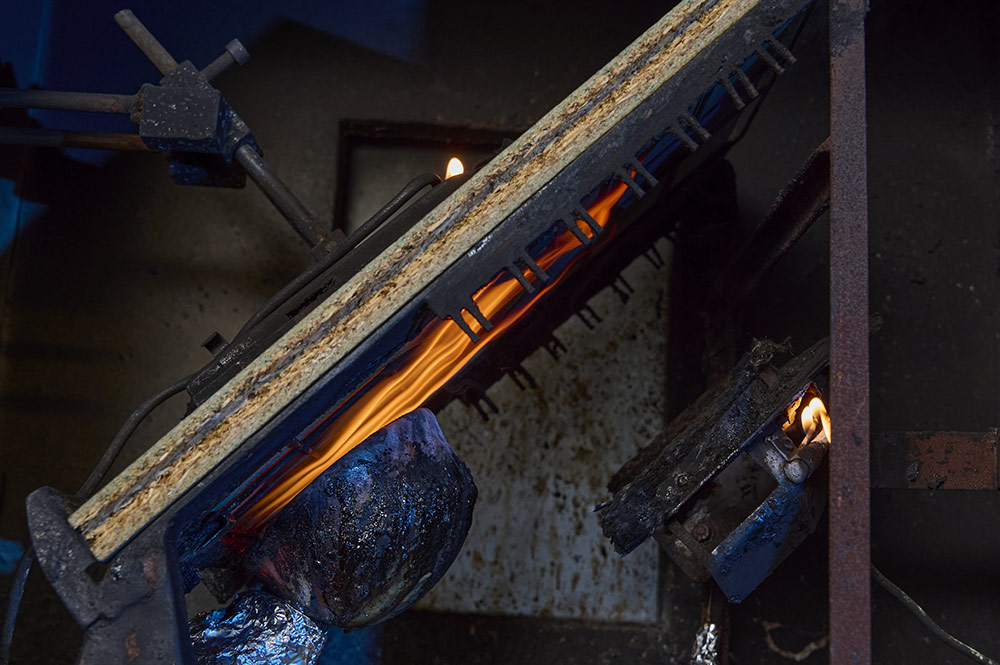
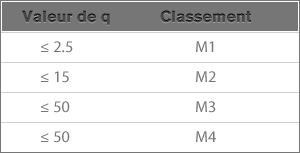
A value q is calculated including the total amount of flame height during the test, the ignition time and the duration of the ignition. The q value gives the final M ranking:
If the material has a particular behavior such as droplets during the NF P 92-501 fire test, additional fire tests have to be led according to the NF P 92-504 and the NF P 92-505.
2. NF F 16-101 – NF P 92-503, Electric candle test - Flame propagation test
Principle : The fire test consists in subjecting the sample to the action of a radiant heat source. A pilot flame is used to cause the ignition of pyrolysis gas. Ignition time, flame persistence and effects of combustion are recorded.
If the material has a particular behavior such as droplets during the NF P 92-503 test, additional tests have to be led according to the NF P 92-504 and the NF P 92-505.

3. NF F 16-101 – NF P 92-504, Flame propagation and persistence test
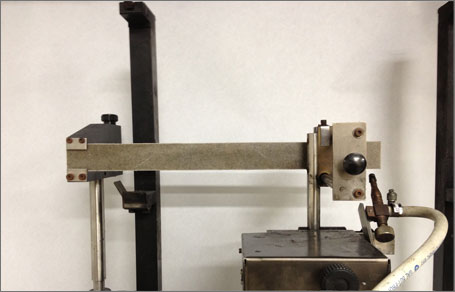
Principle : The fire test consists in subjecting the sample to the action of a little burner in order to cause:
- The ignition of the sample to measure the flame persistence
- A flame propagation effect to measure the flame propagation
4. NF F 16-101 – NF P 92-505, Dripping fire test for thermoplastic materials
Principle : The fire test consists in subjecting the sample to the action of a radiant heat source – epiradiator type – in order to cause:
- The ignition of carbonization gases
- The fall of ignited or non-ignited drops
- The ignition of cellulose wadding placed under the sample
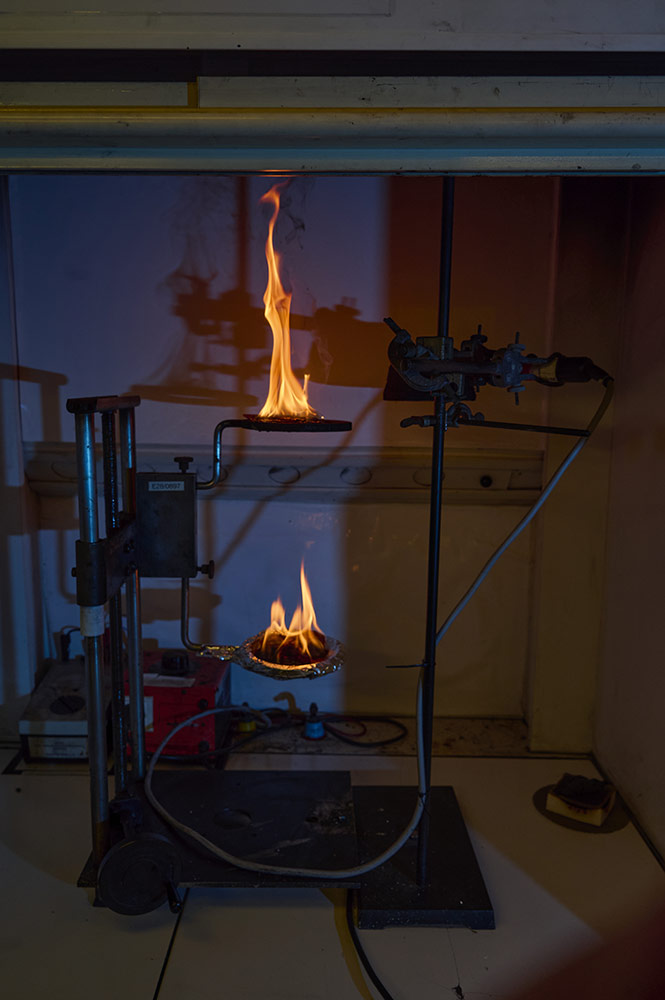
NFPA 130: Reaction to fire test according to US standard
NFPA 130 main fire test method for railway interiors
| End use application of the product | Test description | Test Standard |
|---|---|---|
| Floor covering | Flooring radiant pannel | ASTM E 648 |
| Wall or ceiling covering | Toxicity species released during under ventilated fire | BSS 7239 |
| Wall or ceiling covering | Smoke Density | ASTM E 662 |
| Wall or ceiling covering | Radiant panel | ASTM E 162 |

